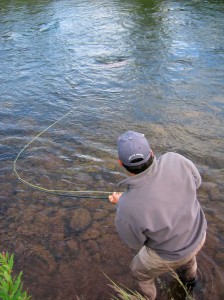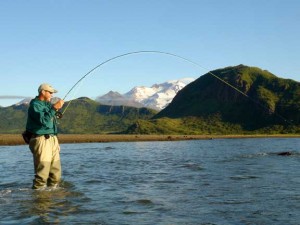Epic Blog
Top Mistakes Made Fighting Salmon in Alaska
03.23.13
If you want to increase your odds of landing more salmon (especially the bigger, more powerful salmon) while you’re on your fly fishing adventure in Alaska, be aware of the following mistakes you can make while actually fighting what may be the biggest fish of your life…
For those of you used to 12 to 18 inch fish, please be aware that the techniques for fighting salmon on fly rod are more akin to saltwater fly fishing techniques than spring creek trout techniques.
Top Mistakes Made Fighting Salmon in Alaska
1. Reel the Fly Line in too Far. As your salmon nears you, keep a fly rod’s length of fly line out the tip of your fly rod. If you reel up so far that the fly line/leader connection is inside your tip guide (where it may get hung up), you can be seriously screwed when a big fish makes a quick, hard run or a violent head shake.
2. Hand on Rod above Cork Handle. Single handed rods are designed for your hand to be on the cork handle. Keep it there. Put the fighting butt of the rod into your chest when your arm or wrist needs a break. Don’t try to cheat by putting your second hand on the rod above the cork for extra leverage for very long… this is a sure way to break a fly rod on a big (or small) salmon.
3. Being Impatient. When you get in a hurry to land a big (or accidentally fouled hooked) salmon, you break rods and leaders or, at minimum, lose flies.
4. Rod Tip too High. Definitely don’t lift your rod vertically past 90 degrees when fighting big, powerful Alaska salmon. Keep it horizontally low with the tip near or in the water. You may actually need to lean your upper body sideways and maybe slightly forward – we call this getting “down and dirty” or “putting the hurt on” the fish.
And after you’ve worn out a big salmon, definitely don’t have your rod tip high while you pull a salmon towards the shore in shallow water to land it – this is a good time to put the rod out in front of you at 45 degrees and just walk backwards.
5. Rod Bent at Tip. With your rod tip up, you fight the fish with the thinnest, weakest section of the rod. The real fighting power in your fly rod is in the lower third, the butt section. How do you engage your rod’s butt? “Getting down and dirty” definitely helps, but essentially you point the butt of your rod away from your body instead of towards it. (The worst case is no bend in your rod whatsoever, so avoid flat and unbent rods.)
6. Rod Pointed Towards Fish. This rod position is necessary at times, but when you’re really trying to wear out a powerful or hot salmon, when he runs to the right rotate your rod to the left and parallel to the water or ground (like in the picture above). This also engages the butt section of your rod. If the fish runs to your left, rotate your rod horizontally to the right.
FINAL THOUGHTS
Please remember, as with any advice, it’s just advice… The above is not meant to cover every situation and every type of fish… there are times when you need to hold your fly rod high above your head or hold it in the traditional fishing fishing position (in front of you and 45 degrees off the water).
Posted in All Posts, Fishing, Tips



